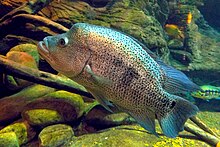| Parachromis dovii | |
|---|---|

| |
| Male Parachromis dovii at the Tennessee Aquarium | |
| Conservation status | |
 Least Concern (IUCN 3.1) | |
| Scientific classification | |
| Domain: | Eukaryota |
| Kingdom: | Animalia |
| Phylum: | Chordata |
| Class: | Actinopterygii |
| Order: | Cichliformes |
| Family: | Cichlidae |
| Genus: | Parachromis |
| Species: | P. dovii |
| Binomial name | |
| Parachromis dovii (Günther, 1864) | |
| Synonyms | |
| |
Parachromis dovii, the wolf cichlid, rainbow bass, or guapote, is a species of cichlid native to Central America, where it occurs in lakes, rivers and streams in Honduras, Nicaragua and Costa Rica. It is one of the largest cichlids, reaching up to 14 kg (31 lb) in weight and 80 cm (2.6 ft) long. A highly predatory species, it mostly feeds on other fish. P. dovii is important to local commercial fisheries, is sought after as a gamefish, and is sometimes kept in aquariums.
Etymology
The fish is named in honor of John Melmoth Dow (1827–1892) of the Panama Railroad Company. As a ship captain and amateur naturalist, he collected the type specimen.
As pets
Parachromis dovii is sometimes sought after by well experienced aquarists. While they are noted for their relatively high intelligence and lifespan of up to a few decades, they require special care due to their large size and high levels of aggression even by cichlid standards, meaning that few — if any — tank mates are possible.
Conservation
Parachromis dovii is widespread in its native range and generally common. Although it has declined locally due to overfishing and pollution, it is not considered threatened. It occurs in Costa Rica's Maquenque National Wildlife Refuge. The species has been introduced to some locations in Central America where it is not native.
References
- ^ Lyons, T.J.; Matamoros, W.A. (2020). "Parachromis dovii (Guapote)". IUCN Red List of Threatened Species. 2020: e.T159145817A159145827. doi:10.2305/IUCN.UK.2020-2.RLTS.T159145817A159145827.en. Retrieved 27 March 2024.
- ^ Froese, Rainer; Pauly, Daniel (eds.). "Parachromis dovii". FishBase. February 2023 version.
- "Parachromis dovii". Fishing World Records. 23 December 2023. Archived from the original on 27 March 2024. Retrieved 27 March 2024.
- ^ Chandler, Patrice (1 March 2024). "Wolf Cichlid: A Care Guide for the Ferocious Tropical Cichlid Species". Badman's Tropical Fish. Archived from the original on 27 March 2024. Retrieved 27 March 2024.
- Christopher Scharpf & Kenneth J. Lazara (22 September 2018). "Order CICHLIFORMES: Family CICHLIDAE: Subfamily CICHLINAE (d-w)". The ETYFish Project Fish Name Etymology Database. Christopher Scharpf and Kenneth J. Lazara. Retrieved 5 January 2022.
- Varga, Mauricio Salas (July 2008). Humedales de Ramsar (FIR) – Versión 2006-2008 (PDF) (Report) (in Spanish). Centro Científico Tropical. p. 20. Archived (PDF) from the original on 27 March 2024. Retrieved 27 March 2024.
| Taxon identifiers | |
|---|---|
| Parachromis dovii | |